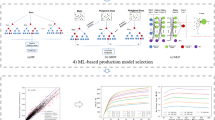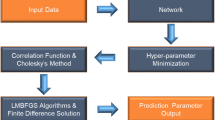Abstract
The micro- and nanopore throats in shale oil reservoirs are finer than those in conventional oil reservoirs and have a larger specific surface area, potentially resulting in a more pronounced crude oil boundary effect. The prediction of recoverable reserves in shale oil reservoirs is influenced by factors such as geological complexity, fracture characteristics, and multiphase flow characteristics. The application of conventional reservoir seepage theories and engineering methods is challenging because of the unique characteristics of shale formations. A novel computational framework is proposed for the prediction of recoverable reserves and optimization of fracturing parameters by combining machine learning algorithms with causal discovery. Based on the theory of causal inference, the framework discovers the underlying causal relationships of the data, mines the internal laws of the data, and evaluates the causal effects, aiming to build an interpretable machine learning model to better understand the properties of shale oil reservoirs. Compared to traditional methods, the interpretable machine learning model has an outstanding prediction ability, with R2 of 0.94 and average error as low as 8.57%, which is 5.22% lower than that of traditional methods. Moreover, the maximum prediction error is only 21.84%, which is 25.2% smaller than the maximum error of traditional methods. The prediction robustness is good. An accurate prediction of recoverable reserves can be achieved. Furthermore, by integrating particle swarm optimization and TabNet, a fracturing parameter optimization model for shale oil reservoirs is developed. According to an on-site validation, this optimization results in an average increase of 13.45% in recoverable reserves. This study provides an accurate reference for reserve assessment and production design in the exploration and development of shale oil reservoirs.
Graphical Abstract













Similar content being viewed by others
Explore related subjects
Discover the latest articles, news and stories from top researchers in related subjects.Data availability
Data sharing not applicable.
Code availability
Code availability not applicable.
References
Pang X, Wang G, Kuang L, Zhao F, Li C, Wang C, Zhang M, Lai J (2023) Lamellation fractures in shale oil reservoirs: Recognition, prediction and their influence on oil enrichment. Mar Pet Geol 148:106032
Drouven M, Cafaro D, Grossmann I (2023) Mathematical Programming Models for Shale Oil & Gas Development: A Review and Perspective. Comput Chem Eng 177:108317
Zhou Q, Lei Z, Chen Z, Wang Y, Liu Y, Xu Z, Liu Y (2023) Shale oil production predication based on an empirical model-constrained CNN-LSTM. Energy Geoscience 5(2):100252
Zhai L, Zhang H, Pan D, Zhu Y, Zhu J, Zhang Y, Chen C (2020) Optimization of hydraulic fracturing parameters based on cohesive zone method in oil shale reservoir with random distribution of weak planes. J Nat Gas Sci Eng 75:103130
Deng H, Sheng G, Zhang H, Ma J, Gong J, Ruan J (2022) Integrated optimization of fracture parameters for subdivision cutting fractured horizontal wells in shale oil reservoirs. J Petrol Sci Eng 212:110205
Jiang Z, Wang W, Zhu H, Yin Y, Qu Z (2023) Review of Shale Gas Transport Prediction: Basic Theory, Numerical Simulation, Application of AI Methods, and Perspectives. Energy Fuels 37(4):2520–2538
Yang P, Zhang S, Zou Y, Li J, Xi Ma, Tian G, Wang J (2023) Fracture propagation, proppant transport and parameter optimization of multi-well pad fracturing treatment. Pet Explor Dev 50(5):1065–1073
Yao J, Li Z, Liu L, Fan W, Zhang M, Zhang K (2021) Optimization of Fracturing Parameters by Modified Variable-Length Particle-Swarm Optimization in Shale-Gas Reservoir. SPE J 26(2):1032–1049
Luo S, Tang H, Zhang L, Wang T, Zhao Y, Chen W (2024) Efficient optimization of fracturing parameters with consideration of fracture propagation and heterogeneity in tight gas reservoirs. Comput Geosci 186:105563
Liu W, Wang S, Dong K, Cheng T (2021) Research on optimization of perforation parameters for formation fractures based on response surface optimization method. PLoS ONE 16(8):e0255793
Xia Y, Wei S, Deng Y, Jin Y (2022) A new enriched method for extended finite element modeling of fluid flow in fractured reservoirs. Comput Geotech 148:104806
Zhang W, Han D, Wang B, Chen Y, Jiao K, Gong L, Yu B (2023) Thermal-hydraulic-mechanical-chemical modeling and simulation of an enhanced geothermal system based on the framework of extended finite element methods - Embedded discrete fracture model. J Clean Prod 415:137630
Xu Y, Xiang Z (2024) A composite model of multi-stage fractured horizontal well with secondary fracture by high-precision boundary element method. Int J Heat Mass Transf 224:125294
Xu Y, Li X, Liu Q, Yang S, Tan X (2021) A semi-analytical solution of finite-conductivity multi-wing fractured well in naturally fractured reservoirs by boundary element method. J Petrol Sci Eng 203:108584
Sharafisafa M, Sato A, Sainoki A, Shen L, Aliabadian Z (2023) Combined finite-discrete element modelling of hydraulic fracturing in deep geologically complex reservoirs. Int J Rock Mech Min Sci 167:105406
Pedro L, Nathan S, José B, Philippe R (2023) DFNMesh: Finite element meshing for discrete fracture matrix models. Adv Eng Softw 186:103545
Huang M, Hu B, Jiang H, Fang B (2023) A water quality prediction method based on k-nearest-neighbor probability rough sets and PSO-LSTM. Appl Intell 53(24):31106–31128
Gurina E, Klyuchnikov N, Antipova K, Koroteev D (2022) Forecasting the abnormal events at well drilling with machine learning. Appl Intell 52(9):9980–9995
Mo F, Jiao X, Li X, Du Y, Yao Y, Meng Y, Ding S (2024) A novel multi-step ahead solar power prediction scheme by deep learning on transformer structure. Renewable Energy 230:120780
Ashraf W, Dua V (2024) Data Information integrated Neural Network (DINN) algorithm for modelling and interpretation performance analysis for energy system. Energy and AI 16:100363
Hui G, Chen Z, Wang Y, Zhang D, Gu F (2023) An integrated machine learning-based approach to identifying controlling factors of unconventional shale productivity. Energy 266:126512
Gou L, Yang Z, Min C, Yi D, Li X, Kong B (2024) A novel domain adaptation method with physical constraints for shale gas production forecasting. Appl Energy 371:123673
Li D, You S, Liao Q, Sheng M, Tian S (2023) Prediction of Shale Gas Production by Hydraulic Fracturing in Changning Area Using Machine Learning Algorithms. Transp Porous Media 149(1):373–388
Hui G, Chen S, He Y, Wang H, Gu F (2021) Machine learning-based production forecast for shale gas in unconventional reservoirs via integration of geological and operational factors. J Nat Gas Sci Eng 94:104045
Yang H, Liu X, Chu X, Xie B, Zhu G, Li H, Yang J (2024) Optimization of tight gas reservoir fracturing parameters via gradient boosting regression modeling Heliyon 10(5):e27015
Zhou G, Guo Z, Sun S, Jin Q (2023) A CNN-BiGRU-AM neural network for AI applications in shale oil production prediction. Appl Energy 344:121249
Wang C, Yang F, Vo T, Nguyen V, Singh M (2023) Enhancing Efficiency and Cost-Effectiveness: A Groundbreaking Bi-Algorithm MCDM Approach. Appl Sci-Basel 13(16):9105
Parviz M, Mostafa M (2023) Enhanced decomposition-based hybrid evolutionary and gradient-based algorithm for many-objective optimization. Appl Intell 53(24):30497–30522
Wang C, Yang F, Vo N, Duong C, Nguyen V (2024) Optimizing Efficiency in BaaS Marketplaces: A DEA-Grey Integration Approach. IEEE Access 12:58532–58550
Ankita SS (2022) Ba-PSO: A Balanced PSO to solve multi-objective grid scheduling problem. Appl Intell 52(4):4015–4027
Duplyakov V, Morozov A, Popkov D, Shel E, Vainshtein A, Burnaev E, Osiptsov A, Paderin G (2022) Data-driven model for hydraulic fracturing design optimization. Part II: Inverse problem. J Petroleum Sci Eng 208:109303
Lu C, Jiang H, Yang J, Wang Z, Zhang M, Li J (2022) Shale oil production prediction and fracturing optimization based on machine learning. J Petrol Sci Eng 217:110900
Liu X, Gao X, Wang Z, Ru X, Zhang Q (2023) A metaheuristic causal discovery method in directed acyclic graphs space. Knowl-Based Syst 276:110749
Tom M, Jitao D (2023) Causal inference in drug discovery and development. Drug Discovery Today 28(10):103737
Min C, Wen G, Gou L, Li X, Yang Z (2023) Interpretability and causal discovery of the machine learning models to predict the production of CBM wells after hydraulic fracturing. Energy 285:129211
Wang H, Li J, Zhu G (2023) A Data Feature Extraction Method Based on the NOTEARS Causal Inference Algorithm. Appl Sci-Basel 13(14):8438
Kevin M, Finbarr M, Barry S, Leandro M, German C (2023) Deep learning in insurance: Accuracy and model interpretability using TabNet. Expert Syst Appl 217:119543
Wang L, Yao Y, Wang K, Adenutsi C, Zhao G, Lai F (2022) Data-driven multi-objective optimization design method for shale gas fracturing parameters. J Nat Gas Sci Eng 99:104420
Wang S, Chen S (2019) Insights to fracture stimulation design in unconventional reservoirs based on machine learning modeling. J Petrol Sci Eng 174:682–695
Luo S, Su H (2022) Study on the Production Decline Characteristics of Shale Oil: Case Study of Jimusar Field. Front Energy Res 10:2296–2598
Funding
This work was supported by the National Natural Science Foundation of China Youth Science Fund Project, [NO: 51904245]; and the Science and Technology Innovation Seedling Project Funding Program of Sichuan Province" Research on prediction method of oil and gas field development index based on interpretable machine learning, [NO: 2022034].
Author information
Authors and Affiliations
Contributions
Huohai Yang: Conceptualization, Project administration, Writing- Reviewing and Editing, Data collection. Yi Li: Software, Methodology, Visualization, Writing- Original draft preparation. Chao Min: Methodology, Supervision. Jie Yue: Investigation, Data curation. Fuwei Li: Investigation, Data curation. Renze Li: Methodology. Xiangshu Chu: Software, Validation.
Corresponding author
Ethics declarations
Conflict of interest
The authors have no competing interests to declare that are relevant to the content of this article.
Ethics approval
Not applicable.
Consent to participate
Not applicable.
Consent for publication
Not applicable.
Additional information
Publisher's Note
Springer Nature remains neutral with regard to jurisdictional claims in published maps and institutional affiliations.
Supplementary Information
Below is the link to the electronic supplementary material.
Rights and permissions
Springer Nature or its licensor (e.g. a society or other partner) holds exclusive rights to this article under a publishing agreement with the author(s) or other rightsholder(s); author self-archiving of the accepted manuscript version of this article is solely governed by the terms of such publishing agreement and applicable law.
About this article
Cite this article
Yang, H., Li, Y., Min, C. et al. Interpretable fracturing optimization of shale oil reservoir production based on causal inference. Appl Intell 54, 13001–13017 (2024). https://doi.org/10.1007/s10489-024-05829-9
Accepted:
Published:
Issue Date:
DOI: https://doi.org/10.1007/s10489-024-05829-9




